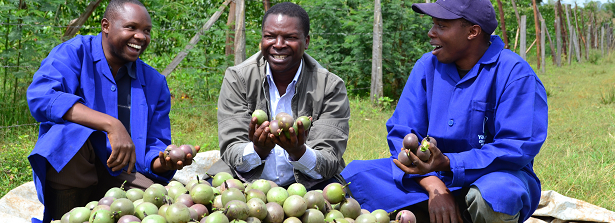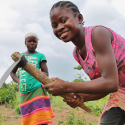Moving forward on youth inclusiveness in agricultural transformation

Youth in agriculture has been high on the development agenda. While many policies and programs are being implemented that should bring youth back to work in agriculture, they are often underpinned by assumptions that could undermine the effective augmentation of food security and employment. To start the discussion by shedding some light on the do’s and don’ts when working with youth, two meetings were organized on youth inclusiveness in agricultural transformation.
The Vijverberg session, part of the foodFIRST series, on December 7, 2016 brought together a wide range of experts. The lunch meeting at the Ministry of Foreign Affairs on December 8, 2016 focused the discussion more on policy implication. The high turnout at both meetings by multidisciplinary stakeholders resulted in interesting insights and debates.
Key-note speech
The key presenter of the meetings, Jim Sumberg from The Institute of Development Studies (IDS), gave a speech to counter some of the current dominant discourses of youth in agriculture. Sumberg is an agriculturalist by training and has over 25 years of experience in working on small-scale farming systems and agricultural research policy in Sub-Saharan Africa and Latin America. IDS has been very active on the topic of youth in agriculture, please find an overview of their work. In his speech, Sumberg argued for more critical engagement in policy and practice upon processes of agricultural transformation, youth un- and underemployment, and youth entrepreneurship. For example, aiming for agricultural transformation at the farmer level versus the system level (cooperation between larger units) determines the kind of programs that can be successful in creating opportunities for youth. Relating to this, we need to distinguish between structural problems which account for a larger group of people, and truly young-specific problems where young people are being systematically and institutionally disadvantaged or discriminated against. Sumberg argued that too many programs are focusing on youth as the entrepreneur and entrepreneurship as the key to employment generation. The assumption is that this will spur agricultural transformation and create opportunities for youth within that process, however it has yet to be seen whether this strategy will be successful. Youth are often targeted, as individual, isolated economic agents, while young people are, for the most part, deeply embedded and even dependent upon networks of family and social relations. Therefore, Sumberg called for a social systems approach. These points were central to the continued debate afterwards. His complete speech can be found here.
Insights from country cases
Next, the insights from a quick-scan study by the F&BKP, INCLUDE Platform and AgriProFocus were presented to illustrate the discussion with country-specific insights. Find the presentation here. This study aimed to assess available evidence in relation to African young people’s engagement with agriculture, and to analyze how this is reflected in current policy and programing in Ghana, Mali and Kenya. The study confirmed that youth policies are mainly looking at youth as the innovator and the entrepreneur, and follows the assumption that augmenting these characteristics will contribute to employment and overall economic growth. There was hardly any distinction made between youth groups – rural/urban, male/female, un-/under-employed – nor was there attention paid to social contexts. Some constraints were targeted more often, such as skills training and access to finance, while others were less targeted, such as access to land. The presentation concluded that a forward looking agenda should better focus on several aspects: the structural versus youth-specific problems; aligning policies better to the social context; integration of the aspiration of youth for their futures; a better distinction between youth; and finally follow an integrated approach to tackle all constraints in one approach. The complete quick-scan report can be found here (PDF).
Linking to experiences from practice
To continue the conversation, three panelists offered their reflections on Mr. Sumberg’s presentation and on the country-specific results of the quick-scan study. The discussion highlighted some interesting practical experiences and perspectives. Agnieszka Kazimierczuk from the African Studies Centre Leiden (ASCL) studied the Kenyan floriculture sector that provides many jobs for Kenyan youth. According to her, large-scale farming could offer a solution to youth inclusiveness in agricultural transformation. Her speech can be found here. Ingrid Flink of the Royal Tropical Institute (KIT), and also the Netherlands’ country representative of YPARD, stressed the importance of really understanding the aspirations of youth for more effective policy and programs. Illustrating this, Flink mentioned a recent study on livelihood choices and options of young people living in rural drylands in Morocco. Furthermore, Flink elaborated on the YPARD mentoring program. Her presentation can be found here. Finally, Gijs Paaimans of Heifer reflected on the necessity of an integrated approach and highlighted the recent EAYIP program which targets livelihoods of youth in Tanzania and Uganda by applying an holistic approach of combining skills building, finance, and youth participation in agribusiness. His reflection can be found here.
Expert debate
At the Vijverberg session, several stakeholders working in this field recognized the constraints and issues, but also critically discussed common narratives that were highlighted in the presentations. Social relations are highly important so cultural factors should be taken into account. Formal data show a high unemployment rate, which rather masks underemployment. There was a lot of discussion around the role of entrepreneurs as not all youth want to become entrepreneurs, but would like to have the security of regular payment. Several participants stressed the importance of creating decent employment, which includes long-term investments in basic structures. Young people that are leaving agriculture can also be seen as part of economic growth and progress. Though agriculture is still expected to offer employment possibilities, research should also focus on how other sectors can absorb a bigger (youth) labor force. That said, there should be more of a variety in policies on different aspirations of youth and youth groups regarding their futures, which also includes better matching of market demand and skills for qualified jobs.
At the second meeting at the Ministry of Foreign Affairs, Teun Meulepas from the Building Bridges foundation, presented highlights from the Road to Nairobi. What was very interesting from his presentation was that one of the main challenges for young entrepreneurs in the agricultural sector is bureaucracy and corruption, which was also found in the quick-scan study. Furthermore, it appeared that almost all agripreneurs that had been interviewed were financially dependent on family, friends or their community, which underpins again the importance of social relations. His complete presentation can be found here. Melle Leenstra of the Inclusive Green Growth direction reflected on these discussions, and he stressed the importance of intergenerational sustainability and that policies should have a youth-sensitive approach. Leenstra also added the importance of looking at the rural-urban dynamics and opportunities in response to Sumberg’s argument for “inclusive rural transformations”. It was agreed not to overlook the role of urban consumers.
Moving forward
Overall as Jim Sumberg concluded, the ambition level of policy makers and practitioners should be much higher. There are several structural issues (such as population growth, corruption and food security) that deserve attention, and a clear distinction should be made between structural problems and youth-specific constraints. A take-home message from Jim Sumberg was to position the way forward around the basic question of, “how do you imagine your future” instead of the overly job-focused question of “what do you want to be when you grow up?” As Sumberg concluded, putting futures and aspirations of youth as the key ambition could create a more long-term engagement context for development agendas.
In the beginning of 2017, AgriProFocus will initiate another Community of Practice meeting for those stakeholders that are interested in linking and learning around this topic. The Food & Business Knowledge Platform will continue to facilitate the development of a Knowledge Agenda on this topic. Please find more information on how to join here.






